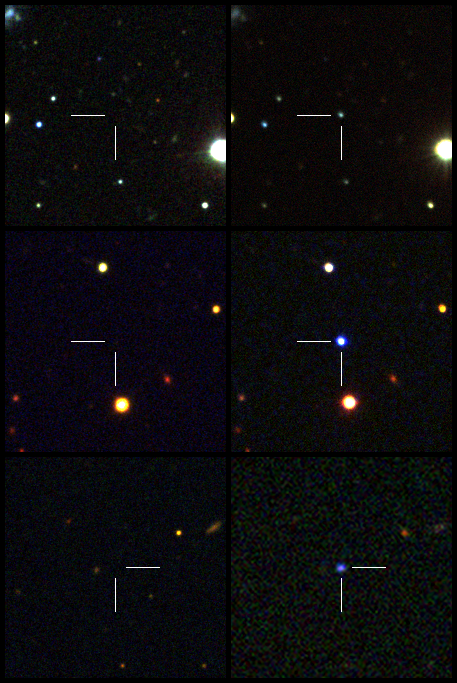Discovery of a New Class of Supernovae
ING web news release
9 June, 2011
Scientists have identified a new type of supernova or exploding star
which is ten times brighter than any other type of stellar explosion.
The new research, "Hydrogen-poor superluminous stellar explosions", is
published by 27 astronomers from Oxford, Caltech, the universities of California and
Toronto, the Weizmann
Institute and other leading institutions.
Because the new supernovae are rare, it took a new type of search to
find them - the
Palomar Transient Factory (PTF). The
PTF is a systematic search for cosmic explosions and uses the Palomar
Observatory 48 inch telescope in San
Diego, California. Many other observatories play critical roles in following-up
the PTF detections -- including the William Herschel Telescope, which in this case was able
to confirm some of these supernovae as extraordinary events, and study
them in detail using the ISIS spectrograph (see Galaxy Supernovae and the WHT).
 |
Three ultraviolet-luminous transients discovered by the PTF.
On the left are before-explosion images; on the right, post-explosion. These
transients were confirmed and studied using telescopes around the world,
including the WHT [ PNG ].
|
Little is known about the physics of these explosions. What we do know
about them is that they are bright and hot—10,000 to 20,000 degrees
Kelvin; that they are expanding rapidly at 10,000 kilometers per
second; that they lack hydrogen; and that they take about 50 days to
fade away—much longer than most supernovae, whose luminosity is often
powered by radioactive decay. So there must be some other mechanism
that's making them so bright.
One possible model that would create an explosion with these
properties involves a pulsating star about 90 to 130 times the mass of
the sun. The pulsations blow off hydrogen-free shells, and when the
star exhausts its fuel and explodes as a supernova, the blast heats up
those shells to the observed temperatures and luminosities.
A second model requires a star that explodes as a supernova but leaves
behind what's called a magnetar, a rapidly spinning dense object with
a strong magnetic field. The rotating magnetic field slows the
magnetar down as it interacts with the sea of charged particles that
fills space, releasing energy. The energy heats the material that was
previously blown off during the supernova explosion and can naturally
explain the brightness of these events.
These supernovae could also reveal what ancient stars might have been
like, since they most likely originate from stars around a hundred
times more massive than the sun—stars that would have been very
similar to the first stars in the universe."
More information:
- R. M. Quimby, S. R. Kulkarni, M. M. Kasliwal, A. Gal-Yam, I. Arcavi, M. Sullivan, P. Nugent, R. Thomas, D. A. Howell, E. Nakar, L. Bildsten, C. Theissen, N. M. Law, R. Dekany, G. Rahmer, D. Hale, R. Smith, E. O. Ofek, J. Zolkower, V. Velur,
R. Walters, J. Henning, K. Bui, D. McKenna, D. Poznanski, S. B. Cenko & D. Levitan, 2011, Nature, doi:10.1038/nature10095.
- "Caltech-led Astronomers Find a New Class of Stellar Explosion", Caltech Press Release, 08/06/2011.
|
|



